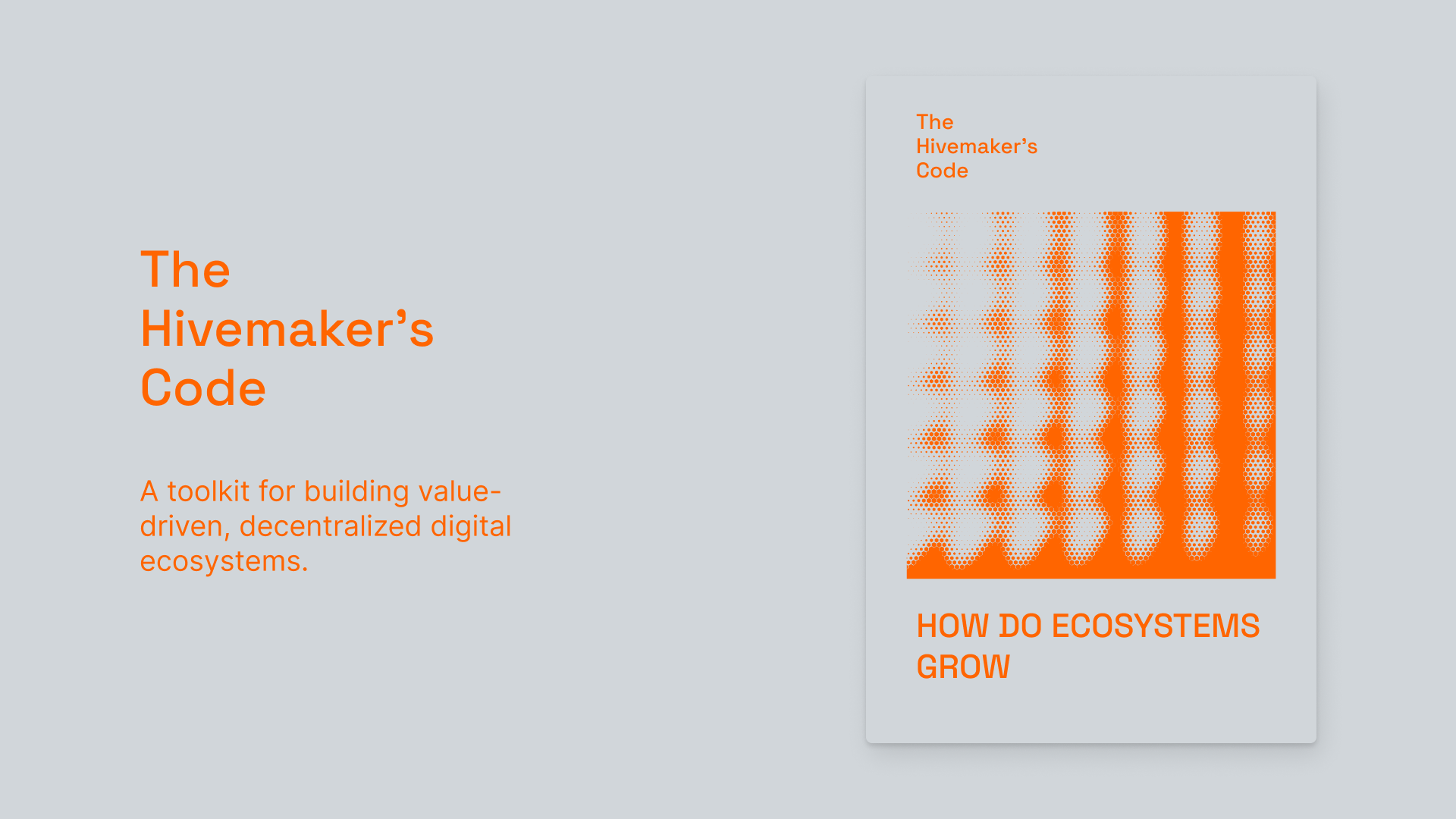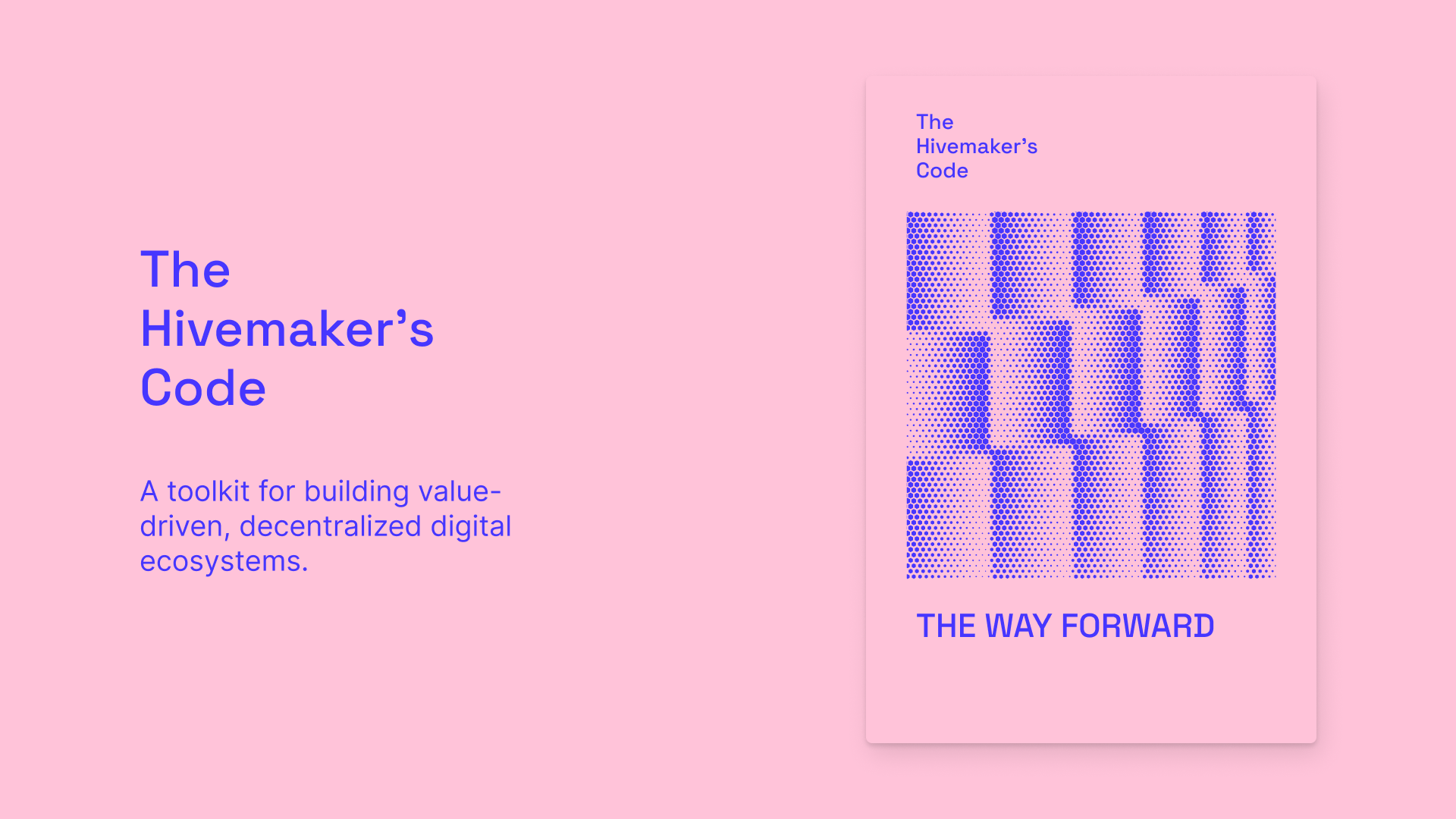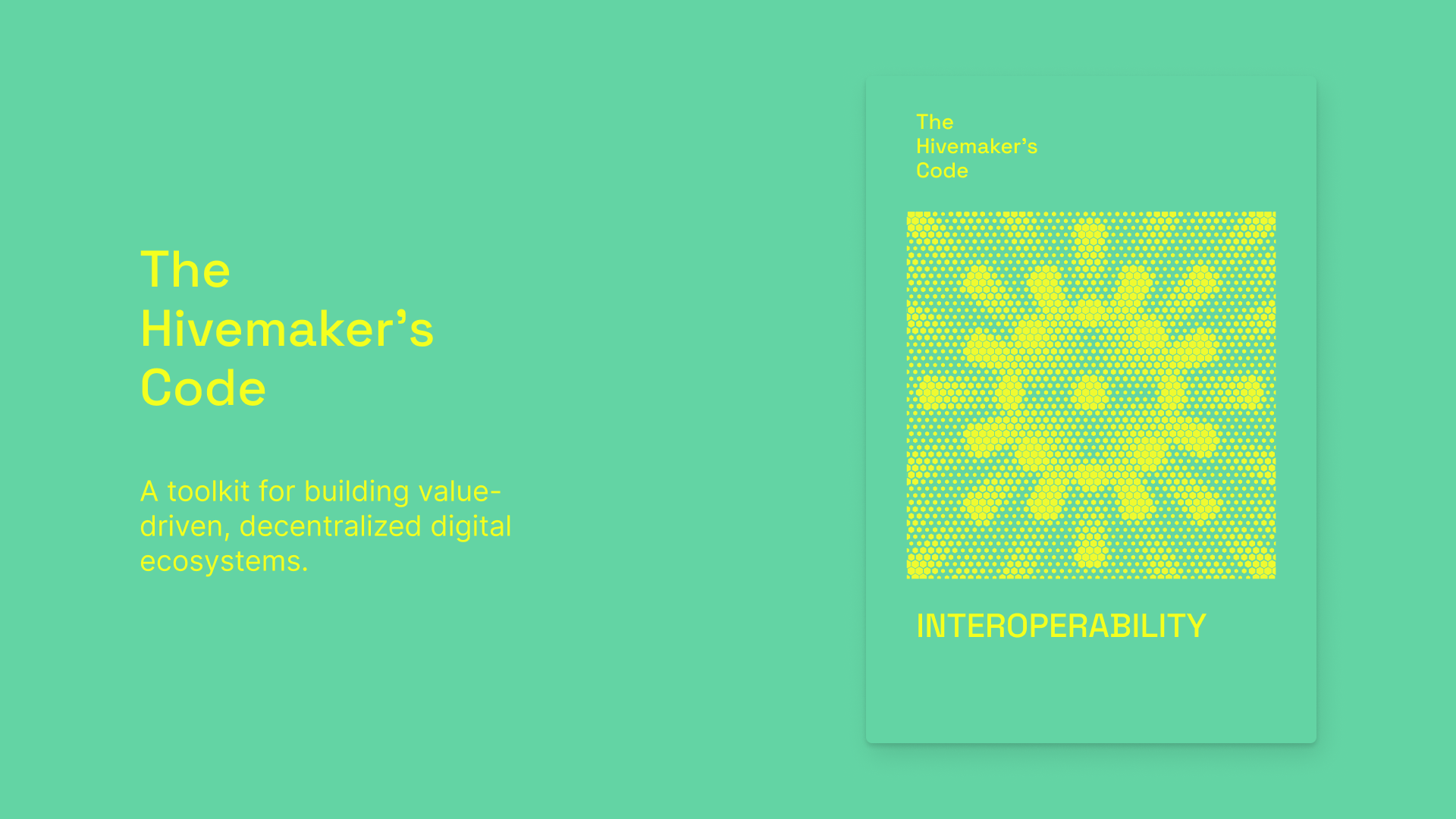This article is part of The Hivemaker’s Code series:
- Article 1: Introduction
- Article 2: How do Ecosystems Grow?
- Article 3: Cooperating on Blockchain
- Article 4: The Satoshi’s Dream
- Article 5: Anonymity in the Cryptosphere
- Article 6: Democracy and Decentralization
- Article 7: Is Net Neutrality Important for Blockchains?
- Article 8: Why Interoperability is the Bedrock of Digital Freedom
- Article 9: The Way Forward
How do Ecosystems Grow?

All By Themselves.
Authors: Oliver Lukitsch, Michal Matlon, Gregor Žavcer, Thomas Fundneider, Markus Peschl, Lena Müller-Naendrup
In 1993, James F. Moore published an article in Harvard Business Review. Inside, he presented an idea that was quite unusual at that time. He claimed that business networks, consisting of interacting companies, products, and users, could be understood similarly to natural ecosystems.
Moore argued that business ecosystems contain various species interacting with each other. And the types of those species co-evolve, just like species in a biological ecosystem.
In hindsight, none of this should surprise us. Early evolutionary biology and ecology were heavily influenced by economics. We know, for example, that the economist Thomas Robert Malthus influenced Charles Darwin.
On the other hand, humans are biological beings that evolved and are still embedded in living ecosystems. Moreover, our economies are nothing more than a technological extension of our natural ecosystems (for better or worse).
Today, the understanding that social and economic systems are ecosystems is widespread. New technologies have always given rise to new niches and even newer technologies, just as the emergence of new species has often given rise to newer species developing and inhabiting newly created niches.
The flower enabled the bee. Web 1.0 enabled email and websites, but also Web 2.0, involving social media, blogging, and online games. And that, in turn, spawned the vision of Web3.
But is it justified to call today’s heavily digitized socioeconomic systems ”ecosystems”? After all, they seem more disembodied, functionalist, and mechanized than any pre-digital or biological ecosystem could ever be.
To answer these questions, we take a brief detour to the basic principles of evolutionary ecology, Darwinism, and the concept of niche creation. The latter, in particular, is critical to understanding why a digital ecosystem can be genuinely alive and exhibit ecological characteristics initially considered unique to biological ecosystems.
What is Life Anyway?

Autonomy and Self-Organization
Before we wonder why digital ecosystems deserve to be treated as “living systems,” we should revisit the very basics of biology. What does it mean for an organism or object to be a living system?
Many biologists list a set of features only present in living organisms. These can be growth, sensitivity to external stimuli, reproduction, homeostasis, adaptivity and learning, and being composed of cells. Such definitions, however, do not fully capture the uniqueness of living systems.
The mathematical models of theoretical biology are based on more fundamental assumptions about life. For instance, the biologist Stuart Kauffman contends we must define life in terms of its “autonomy.” Living systems are self-organized systems. They bring about their very own organization.
You might find this definition too simple for something as complex as life. Though surprisingly spartan, it’s a definition that performs well. Stones do not organize themselves. Cars don’t organize themselves. Even intelligent machines organize themselves only because we designed them to do so. Not because they evolved that way themselves.
On the contrary, life was created by no one and for nothing. If it were not self-organized and autonomous, it would do nothing at all. Life came about by itself, simply reproducing its own emergent structure.
The biologists Humberto Maturana and Francisco Varela coined the term “autopoiesis” to capture this fundamental feature of life. According to them, life does not only create and organize itself. It also creates its very own domains of meaning, its niches. In doing so, it can sustain its unstable internal state against an unstable environment. Hence, life creates its very own environmental conditions for sustaining itself.
Bottom-Up Versus Top-Down: The Emergence of Life Forms
To a large extent, life is the engine of its own creativity. Life is profoundly autonomous. Since there can be nothing that transcends life and gives it form and meaning, there is only one “direction of creation”: life arose from the bottom-up. It just “emerged” from the self-reproducing patterns of interacting molecules.
These features of life do not only apply to individual organisms. They apply to single cells, individuals, groups, and entire ecosystems. Like a single organism constantly brings forth its own organization, so does the ecosystem. There is no external entity guiding the fate of an ecosystem. Its structure and organization emerge from themselves until they no longer do, and the ecosystem ceases to exist.
You might argue that there actually is something that shapes life, a force greater than its internal organization: natural selection. Natural selection is considered the driving force of evolution. It forces organisms to play by their own rules and, more importantly, by the laws of the environment around them. It imposes on life.
But is the course of evolution really determined by an external force? Is natural selection a substitute for the idea of a higher being, who was said to have formed all living things on earth? We will show you in a moment that even Darwin rejected the notion that natural selection is the sole driving force of evolution.
Misconceiving Darwin
 Charles Darwin is as influential as he is misunderstood. He famously maintained that only the fittest survive. This claim is often interpreted as meaning that only the “strongest” survive. Just think of majestic lions and clever apes that dominate their ecosystems.
Charles Darwin is as influential as he is misunderstood. He famously maintained that only the fittest survive. This claim is often interpreted as meaning that only the “strongest” survive. Just think of majestic lions and clever apes that dominate their ecosystems.
However, fitness has nothing to do with the strength or intelligence of individual organisms. Instead, it measures how a species can reproduce successfully in its environment. Staying alive is a collective, multigenerational project any species must pursue. In that sense, only the entire species matters.
True, Darwin uses the superlative: “Only the fittest are being selected by nature.” This is true, but only because two species compete for the same resources. The fittest, in this sense, is the organism that uses the resources in a niche more effectively than its niche mates.
According to its intellectual father, evolution is not only about optimization and competition. It’s also about the inherent biological, natural creativity of evolutionary dynamics, as Stuart Kauffman notes. How do organisms produce the unique forms, functions, and abilities that make our ecosystems colorful and diverse?
Natural selection is a mechanism that selects already existing shapes and forms (or phenotypes, as biology calls them). But how do the various biological forms and shapes arise, to begin with?
Random mutation is often given as one part of the explanation. Yet, it forms only one piece of the puzzle resulting in a vast and increasing complexity of organisms. To make things worse, biologists consider it a highly effective survival strategy to stick with simplicity, be small, and produce lots of offspring at speed. It’s a strategy that works flawlessly for the amoeba but fails the elephant.
Being small, simple, and highly reproductive will always be effective for life. Bacteria will continue to populate our planet even after more complex life forms have become extinct. It is puzzling enough that complexity emerges at all. Therefore biology must explain why the forces of evolution cause more complexity in nature on earth, not less. Why is it feasible to evolve for large, complex, ecologically sensitive organisms like us?
The Problem of the Heap. Natural Drift as its Solution.
When does a heap become a heap? You may wonder why the topic of the evolution of complexity has led us to this question. You will soon see that it’s vital to the question of how increasing biological sophistication arises.
There are two ways to explain the emergence of growing complexity. As we mentioned, some biologists have chosen to explain everything about the emergence of life’s complexity with the concept of natural selection. But it’s by no means anti-naturalist or “esoteric” to assume that natural selection is not all there is to biological evolution.
Other mechanisms have already been identified. The most important concept is the idea of “natural drift” or “genetic drift.” Some properties of organisms can emerge without any selective pressure from the outside. They can materialize even though they are merely viable despite being necessary for survival and reproduction.
While it was a given for a long time that natural selection was the only mechanism driving evolution, so-called “neutral” theories emerged from the 1960s onward, attempting to explain how complexity arises in the absence of natural pressures.
One such theory, the “theory of constructive neutral evolution,” argues that biological changes do happen even without selective pressure. The story goes like this: Evolution can bring forth so-called “silent” changes (that don’t serve any purpose or function) and functional changes (that give rise to new functions).
Evolution proceeds without being imposed by the external environment when such changes occur by mutation and are passed on to new generations. It is purely constructive rather than selective.
Stephen J. Gould, for example, described the evolution of some traits that initially had no function or at least a different function. He calls such features “exaptations.” Usually, you could think that as long as a biological trait cannot fulfill a function, nature has no “reason” for selecting it. Why should she? There is simply no advantage for an organism to have “useless” traits.
Nonetheless, such seemingly useless traits must first emerge to later grow into a functional unit. There’s a clear-cut finishing line that defines when a complex structure (such as an organ) attains its identity: it’s when it can obtain a purpose or function. And only once it does can it be selected by nature.
To give an example, think of the evolution of some skeletal structure that will, later in its evolutionary history, allow the descendants of some creature to fly. Note that the skeletal structure will not perform its purpose at the beginning of its evolution. It will resemble wings ever so slightly – but it’s still a long way. First, it will exist for no reason at all. Hence, there are no grounds for “selection.” The structure will have to evolve over multiple generations without notable prospects of usefulness.
At some point in time, a distant descendant of the original creature will suddenly have a subtly different skeletal endowment than its immediate ancestor. The latter looks like a promising flyer, but he isn’t. For the former, however, it will be just enough to get it up into the air. Only then can we speak of a new organic feature that can be selected for its novel purpose.
Niches Spawn Niches, Spawn Niches…
 The above story also affects how we think about ecological niches. Every organism on our planet occupies a niche. Niches provide a space where an organism has little competition for resources because it adapts to its environment in ways other organisms can’t. It’s simply a “nice place” for any organism to be. More importantly, you could say that an organism’s niche defines its functions and place in nature - its purpose.
The above story also affects how we think about ecological niches. Every organism on our planet occupies a niche. Niches provide a space where an organism has little competition for resources because it adapts to its environment in ways other organisms can’t. It’s simply a “nice place” for any organism to be. More importantly, you could say that an organism’s niche defines its functions and place in nature - its purpose.
Thus, a niche is what transforms an “exaptation” (a previously useless trait) of an organism into something “meaningful.” It enables and further shapes the purpose of that trait.
Organisms can find their niches even in extreme environments where no other species can live. For instance, take one of the most primitive forms of single-cell microorganisms called “archaea.” They inhabit areas with very high levels of salinity, acidity, and extremely high temperatures. And such species have been ecologically highly dominant in evolutionary history.
One thing is remarkable about this fact. Archaea are very primitive organisms. On the other hand, more highly evolved organisms usually occupy niches, whether other organisms thrive too. They have co-evolved with other organisms and not just with their inorganic environment.
It’s no accident that more organized and complex organisms live this way. The reason is that living organisms provide potential niches for other organisms to occupy. They increase the number of contexts in which other species can accidentally use novel traits, thus giving them meaning.
A Short Story About Evolution
Imagine a free-swimming protozoan, a single-cell organism. It happens to develop a property that allows it to firmly attach itself to rocks in the ocean where it lives. Its offspring also stick to the seafloor and consume anything that washes up in their direction. Soon, all rocks on the seafloor are covered by this new species.
Another type of cell, a different, free-floating species, might appear nearby. By chance, it might have developed the ability to eat other cells. Among them, the settling, immobile protozoan organism stuck on the rocks. It gets its energy from them, allowing it to create new offspring and consume even more settling protozoans. But since the rock-sticking protozoans reproduce more quickly than the predator, both species can occupy their respective niches in the long term.
This example shows how a new niche is created. The environment didn’t cause the predator and its trait to be selected. Instead, the settling protozoa enabled the thriving of a newly evolved predator.
This case shows that life creates the potential for new niches. It is a catalyst for the emergence of new life forms, and exponentially so. Biodiversity creates more biodiversity - potential new niches proliferate as species occupy previous niches.
Niches in Human Ecosystems and the Economy

So what does all of this have to do with the economy? Evolutionary biologist Robert Cazzolla Gatti and his colleagues have explored how to translate the story above to the human context.
Many economists have used biological and ecosystem metaphors to explain how markets evolve. Many also conceive of a market ecosystem as a predefined space into which their products need to fit. And we will soon show it might not be entirely correct.
These economists say a company can identify its future niches in advance. They think a market ecosystem can be divided into narrower niches, which the companies can then occupy. However, sticking with this notion of niches can lead an organization to focus on incremental improvement and optimization.
For example, think of the bicycle. It occupies a niche as a means of transportation. It excels in many uses, where the train or ship doesn’t. And the bicycle niche was sliced into many distinct niches. There are racing, commuter, mountain, gravel, and e-bikes.
None of these types, when invented, reinvented the wheel. They are just versions of the original bicycle. Some are faster and lighter, and some are more casual and practical. However, a bike remains a bike with additional features, functionalities, and applications.
Niche partitioning certainly increases diversity within a socioeconomic system like a market. However, it does not create genuine novelty. It doesn’t lead to radical innovation.
True innovation arises only through what is called “niche creation.” A new niche is created when it’s not a subset of an existing one, enabling a new way of interacting with the environment.
Think of the first organisms that were capable of photosynthesis. Their emergence led to an explosion of opportunities for other organisms to emerge. They enriched the Earth’s atmosphere with oxygen and enabled the emergence of organisms with lungs.
Genuinely new niches create an entirely new context. This is why niche emergence is said to have an “autocatalytic” (self-enabling) dynamic. That is, niche emergence leads to more niche emergence, as the biologist Stuart Kauffman argued.
Life Enables Novelty
Take, for example, the invention of the personal computer, which, in turn, enabled the creation of word processors. The creation of word processors then led to an explosion of files, subsequently promoting the exchange of files. According to Stuart Kauffman, this was ultimately the basis for developing the internet protocol.
The advent of the Internet, in turn, created a new niche with unprecedented scale and impact on every aspect of our lives. It created a new context that spawned many other new niches, such as social media and digital platforms.
To summarize, there is a clear difference between the emergence of new niches and the partitioning of existing ones. The former is likely to provide an ever-new context for the emergence of new niches. The latter is a path to relatively predictable optimization, adaptation, and specialization.
Both phenomena have their place in nature, culture, and economics. However, any project which aims to change society (be it an analog or a digital one) must pay attention to the idea that novelty evolves only when enabling the cascading dynamics of niche emergence.
Conclusion: Niche Creation is a Foundation of Living Digital Ecosystems
 Life’s ability to create new niches is a fundamental feature of biology. It is the lifeblood of evolution and the biological possibility to develop new life forms and meanings.
Life’s ability to create new niches is a fundamental feature of biology. It is the lifeblood of evolution and the biological possibility to develop new life forms and meanings.
If an ecosystem cannot enable new forms of life, it may not deserve to be called a living ecosystem. But why should we bother with these concepts? If a digital ecosystem works as it is, why should we bother making it a “living ecosystem”?
We began the article by asking whether digital systems, such as Web 2.0 and Web3, are real ecosystems – whether they are genuinely living systems. Digital ecosystems, more than any other social ecosystem, seem highly disembodied, rule-based, and mechanized, especially when compared to a pre-digital ecosystem. Living ecosystems seem to be quite the opposite.
Moreover, our behavior on today’s web is often driven and shaped by algorithms that act in the interest of the companies that made them. We seem to lack the autonomy of living beings embedded in living ecosystems.
While in living ecosystems, no central authority guides the behavior of various species, what we do on Web 2.0 is shaped by the platform owners in a more or less top-down manner. On the other hand, living ecosystems get organized and emerge from the bottom-up.
The idea that Web 2.0 is a living ecosystem seems far-fetched. It is a stretched metaphor. It is too strongly controlled and shaped by the top-down influence of various tech giants.
But what about the prospects for Web3? Aren’t decentralized infrastructure and the possibility of strengthening the autonomy of individual users the right way to breathe life into a digital system?
A Living Web3
There is a case to be made for designing Web3 ecosystems that strive for liveliness. Living ecosystems are truly decentralized ecosystems. Nothing truly steers an ecosystem. Nobody imposes values onto an ecosystem precisely as planned, even though it can be designed for a purpose. Nobody wholly owns or controls it.
One of our next articles on Web3 and democratic values shows that blockchain-based ecosystems often leave the promise of decentralization and user empowerment unfulfilled. Power can quickly accumulate and lead to the same centralized structures that Web3 seeks to overcome.
On the contrary, a truly decentralized and living blockchain ecosystem will have the much-needed characteristics to resist the tendency toward centralization. After all, a living system is a place that creates more autonomy and creates new niches. To live means to let live. Any Web3 ecosystem that allows its members to live and grow on their own terms has paved the way for its own liveliness.
Keystone Species: A Critical Enabler Revisited
 In the 1960s, the biologist Robert Paine carried out a series of studies to show how predators influence the diversity of species in an ecosystem. What happens if they are removed? Does the number of species increase if top-level predators prey less on ecosystem members?
In the 1960s, the biologist Robert Paine carried out a series of studies to show how predators influence the diversity of species in an ecosystem. What happens if they are removed? Does the number of species increase if top-level predators prey less on ecosystem members?
For the community of ecologists and biologists, the answer to these questions was somewhat surprising. Paine had an unorthodox hypothesis. Predators at the top of the ecosystem might reduce the number of their preferred prey. However, their absence might lead to a radical decrease in species diversity upon leaving the ecosystem.
To test this, Paine selected a piece of the shoreline of the Washington State coast. He then removed the starfish preying on mollusks in the said area and observed how this changed the biodiversity. The experiment confirmed his hypothesis. A year later, the species in the observed area declined from fifteen to just eight.
Another striking example of how the decimation of a species can change the tides of an ecosystem and reduce its biodiversity is the gray wolf in the United States. Because the wolf hunted livestock primarily in Yellowstone National Park, the U.S. government intervened and killed all wolves inhabiting the area.
Because gray wolves mainly hunted elk, the population of its prey quickly recovered and eventually exploded. However, more elk do not bode well for the well-being of the rest of the ecosystem. More elk eat more plants, and plants provide food, shade, and shelter for other species. They form niches for other members of the ecosystem. Through this intervention, these niches disappeared. Once again, the vanishing of a predator at the top of the food chain led to ecological devastation rather than recreation.
In the 90s of the last century, the wolf was resettled in the Yellowstone ecosystem. This increased the population of different plant species, such as the willow, which led to an increase in the beaver population. The reintroduction of the wolf led to the recreation of the original ecosystem.
This is why wolves started to be considered “keystone species” for the Yellowstone ecosystem. Ones whose presence is foundational to the functioning of the whole system and thriving of other species.
It’s important to note that the keystone species concept does not consider ecosystems as having any “optimal” states into which they can be engineered by reintroducing top predators.
The only thing we can achieve is re-attain the historical dynamics of such an ecosystem. However, we can say that keystone species play a critical role in an ecosystem’s biodiversity, enabling the proliferation of niches and, thus, species inhabiting it.
We can also use the concept of keystone species when thinking about the creation of living digital ecosystems. Many new ecosystems face the “chicken and egg problem.” The motivation of new users (species) to join it often depends on other types of users being already present there. A real-estate renting platform will find it difficult to attract future tenants if few landlords post their apartments.
One way to overcome this problem is to identify one such keystone species, a specific user group, and invest most of the organization’s energy into attracting these users. Their presence will, in turn, attract the other groups and enable the rest of the value chain to complete itself.
Key Insights

- Living digital ecosystems should be decentralized, just like living biological ecosystems.
- Living digital ecosystems provide the framework for ever new niches.
- A purely “selectivist” approach to enabling the creation of new niches deteriorates the autonomy of an ecosystem’s members.
References
 Cattani, G. and M. Mastrogiorgio (Eds.) (2021). New developments in evolutionary innovation. Novelty creation in a serendipitous economy. Oxford: Oxford University Press.
Cattani, G. and M. Mastrogiorgio (Eds.) (2021). New developments in evolutionary innovation. Novelty creation in a serendipitous economy. Oxford: Oxford University Press.
Cazzolla Gatti, Roberto, Brian Fath, Wim Hordijk, Stuart Kauffman, and Robert Ulanowicz. 2018. “Niche Emergence as an Autocatalytic Process in the Evolution of Ecosystems.” Journal of Theoretical Biology 454: 110–17. https://doi.org/10.1016/j.jtbi.2018.05.038.
Cazzolla Gatti, Roberto, Roger Koppl, Brian D. Fath, Stuart Kauffman, Wim Hordijk, and Robert E. Ulanowicz. 2020. “On the Emergence of Ecological and Economic Niches.” Journal of Bioeconomics 22 (2): 99–127. https://doi.org/10.1007/s10818-020-09295-4.
Gould, Stephen Jay, and Richard Lewontin. 1979. “The Spandrels of San Marco and the Panglossian Paradigm: A Critique of the Adaptationist Programme.” Proceedings of the Royal Society B: Biological Sciences 205: 581–89.
Kauffman, S.A. (1993). The origins of order: Self-organisation and selection in evolution. Oxford: Oxford University Press.
Kauffman, S.A. (2014). Prolegomenon to patterns in evolution. BioSystems 123(2014), 3–8.
Kauffman, S.A. (2016). Humanity in a creative universe. New York: Oxford University Press.
Koppl, R., S. Kauffman, T. Felin, and G. Longo (2014). Economics for a creative world. Journal of Institutional Economics 2014, 1–31.
Humberto R. Maturana and Francisco Varela. 1987. The Tree of Knowledge: The Biological Roots of Human Understanding. Boston: Shambhala Press.
Paine, Robert T. 1966. “Food Web Complexity and Species Diversity.” The American Naturalist 100 (910): 65–75.
Stoltzfus, Arlin. 1999. “On the Possibility of Constructive Neutral Evolution.” Journal of Molecular Evolution 49 (2): 169–81. https://doi.org/10.1007/PL00006540.
Discussions about Swarm can be found on Reddit.
All tech support and other channels have moved to Discord!
Please feel free to reach out via info@ethswarm.org
Join the newsletter! .




